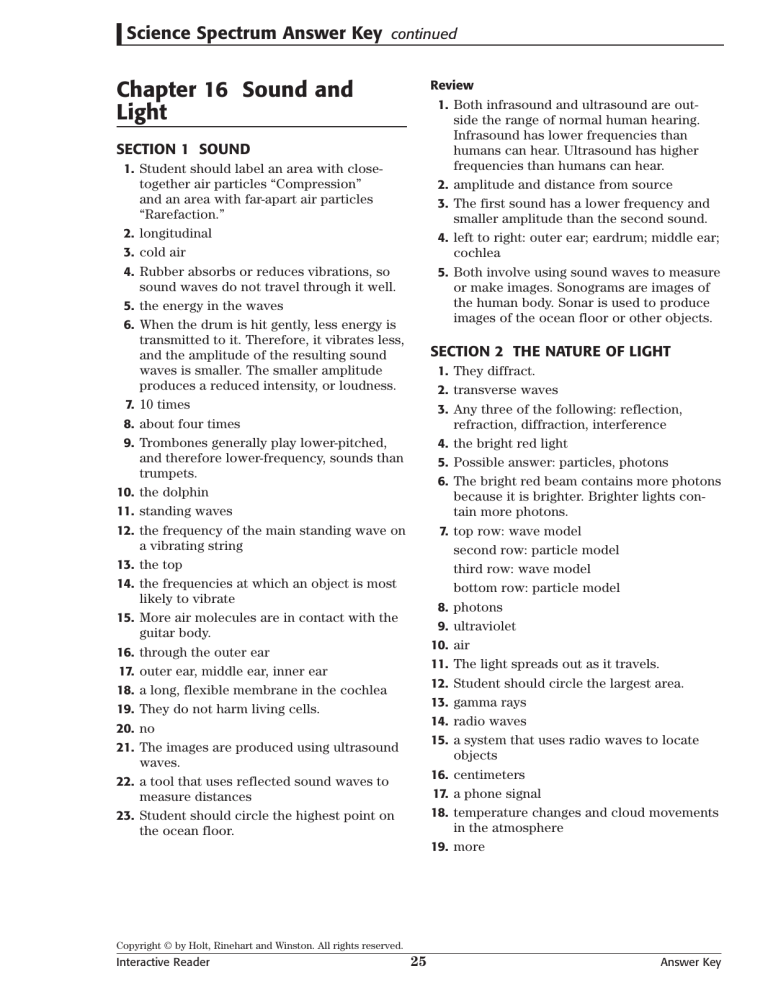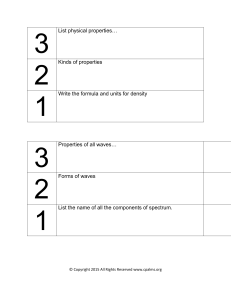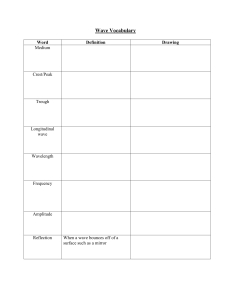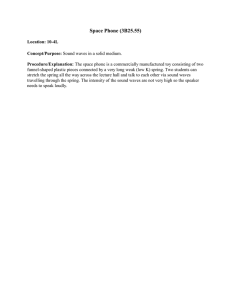
Science Spectrum Answer Key continued Chapter 16 Sound and Light Review 1. Both infrasound and ultrasound are out- SECTION 1 SOUND 1. Student should label an area with close- 2. 3. 4. 5. 6. 7. 8. 9. 10. 11. 12. 13. 14. 15. 16. 17. 18. 19. 20. 21. 22. 23. 2. 3. together air particles “Compression” and an area with far-apart air particles “Rarefaction.” longitudinal cold air Rubber absorbs or reduces vibrations, so sound waves do not travel through it well. the energy in the waves When the drum is hit gently, less energy is transmitted to it. Therefore, it vibrates less, and the amplitude of the resulting sound waves is smaller. The smaller amplitude produces a reduced intensity, or loudness. 10 times about four times Trombones generally play lower-pitched, and therefore lower-frequency, sounds than trumpets. the dolphin standing waves the frequency of the main standing wave on a vibrating string the top the frequencies at which an object is most likely to vibrate More air molecules are in contact with the guitar body. through the outer ear outer ear, middle ear, inner ear a long, flexible membrane in the cochlea They do not harm living cells. no The images are produced using ultrasound waves. a tool that uses reflected sound waves to measure distances Student should circle the highest point on the ocean floor. 4. 5. side the range of normal human hearing. Infrasound has lower frequencies than humans can hear. Ultrasound has higher frequencies than humans can hear. amplitude and distance from source The first sound has a lower frequency and smaller amplitude than the second sound. left to right: outer ear; eardrum; middle ear; cochlea Both involve using sound waves to measure or make images. Sonograms are images of the human body. Sonar is used to produce images of the ocean floor or other objects. SECTION 2 THE NATURE OF LIGHT 1. They diffract. 2. transverse waves 3. Any three of the following: reflection, 4. 5. 6. 7. 8. 9. 10. 11. 12. 13. 14. 15. 16. 17. 18. 19. refraction, diffraction, interference the bright red light Possible answer: particles, photons The bright red beam contains more photons because it is brighter. Brighter lights contain more photons. top row: wave model second row: particle model third row: wave model bottom row: particle model photons ultraviolet air The light spreads out as it travels. Student should circle the largest area. gamma rays radio waves a system that uses radio waves to locate objects centimeters a phone signal temperature changes and cloud movements in the atmosphere more Copyright © by Holt, Rinehart and Winston. All rights reserved. Interactive Reader 25 Answer Key Science Spectrum Answer Key continued Review 1. Possible answers: police use radar to track the 2. 3. 4. 5. 6. 11. white 12. It absorbs all colors of visible light. speed of vehicles; air-traffic control uses radar to track location and elevation of aircraft. Neither model can completely explain all the observations about the behavior of light. Observations that support the wave model include the fact that light shows reflection, refraction, diffraction, and interference. Observations that support the particle model include the fact that light can travel through a vacuum and that light can cause electrons to fly off pieces of metal. The energy of photons of light is proportional to the frequency of the electromagnetic waves. Therefore, photons associated with visible light have more energy than photons associated with radio waves, because visible light has higher frequencies than radio waves. UV light has high enough energy that it can pass through clouds. It can give you a sunburn. Sunscreen protects skin by absorbing or blocking ultraviolet light before it reaches your skin. gamma rays, X rays, ultraviolet rays, visible light, infrared light, microwaves, radio waves Review 1. to make it easier to understand and predict 2. 3. 4. 5. SECTION 4 REFRACTION, LENSES, AND PRISMS 1. 2. 3. 4. SECTION 3 REFLECTION AND COLOR 1. an imaginary line that shows the direction in 2. 3. 4. 5. 6. 7. 8. 9. 10. how light waves will behave during reflection and refraction Answers will vary. Students should give examples of objects that are dull or matte in appearance. Objects that produce diffuse reflection look dull. Student should label the vertical line “Normal,” the angle between the downward-pointing line and the normal “Angle of incidence,” and the angle between the upward-pointing ray and the normal “Angle of reflection.” Possible answers: 25°, or the same as the angle of incidence A blue object reflects blue light. If you shine red light on it, there is no blue light for it to reflect, so it appears black. which light travels dull The angle of incidence of a light ray is equal to the angle of reflection. Student should draw an incoming ray that makes a smaller angle with the normal, and a reflected ray that makes the same angle with the normal, but is on the other side of the normal. a virtual image His brain interprets the reflected light waves as if they traveled in a straight line from behind the mirror. They distort reflected images. Light rays pass through a real image, but they do not pass through a virtual image. the relative positions of the object and the mirror the wavelengths of light it reflects 5. 6. 7. 8. 9. 10. 11. Its speed changes. It decreases. air Light reflecting from below the water refracts as it moves from the water to the air, producing a virtual image that your eye detects. Student should circle the point at which all of the light rays converge. virtual Muscles around the lens change its shape to change the amount that light is refracted. violet violet the separation of light into different colors because of differences in wave speed dispersion and reflection Review 1. Dispersion occurs because different wave- lengths of light refract by different amounts when they pass through a prism. 2. In order of flow chart: cornea; lens; lens; retina; rods; cones; optic nerve Copyright © by Holt, Rinehart and Winston. All rights reserved. Interactive Reader 26 Answer Key Science Spectrum Answer Key continued Review 1. In electrical conductors, electrons can 3. Possible answers: magnifying glass, human eye, microscope 4. Rainbows form because of a combination of dispersion and reflection. Dispersion happens because different wavelengths of light travel at different speeds in a medium. If all wavelengths of light traveled at the same speed in a given medium, no dispersion would occur, and rainbows would not form. 5. converging 6. green light 2. Chapter 17 Electricity 3. SECTION 1 ELECTRIC CHARGE AND FORCE 1. 2. 3. 4. 5. 6. 7. 8. 9. 10. 11. 12. 13. 14. 15. 16. 17. 18. The particle has a positive charge. electrons They have opposite electric charges. negative 1.6 1019 C Electrons are located in the outer parts of an atom. The toaster would not work if the cord were made entirely of plastic. Plastic is an insulator, so electricity does not flow through it easily. It contains the same number of protons as electrons. It has a negative charge, so it must have more electrons than protons. friction Electrons cannot move easily through an insulator. positive a force a charged object experiences due to interactions with other charged objects amount of charge on each object and distance between the objects away from each other a force that can affect objects that are not touching because a positively charged object will repel another positively charged object Electric field lines show how a positively charged particle would move. A positively charged particle would be repelled by the positively charged particles in the left image. 4. 5. move freely throughout the substance. Therefore, electrical conductors can transfer electric charge easily. In electrical insulators, electrons cannot move freely. Therefore, electrical insulators do not transfer electric charge easily. There is more friction between your feet and a carpeted floor than between your feet and a smooth floor. The greater friction causes more electrons to move between the floor and your body. More electrons will move into student A’s body than into student B’s body. Therefore, the difference in electric charge between student A and the doorknob will be greater. Student A is more likely to receive an electric shock. The greater the charges, the greater the electric force. toward the object SECTION 2 CURRENT 1. energy that charged objects have that 2. 3. 4. 5. 6. 7. 8. 9. 10. 11. 12. 13. 14. 15. 16. 17. depends on their position in an electric field It decreases. It would decrease. voltage 12 V from areas of high potential to areas of low potential electrons from right to left the slowing of the movement of charged particles through a substance resistance They travel through the wires in the bulb. by dividing voltage by current V IR; V (0.50 A) × (12 7); V 6 V Electrons can move through them easily. Metal is a better electrical conductor than plastic, so the metal fork probably has lower resistance than the plastic fork. to allow electricity to flow through the device a material that has no resistance below a certain temperature Copyright © by Holt, Rinehart and Winston. All rights reserved. Interactive Reader 27 Answer Key




